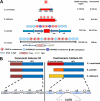Diversity in requirement of genetic and epigenetic factors for centromere function in fungi
- PMID: 21908596
- PMCID: PMC3209047
- DOI: 10.1128/EC.05165-11
Diversity in requirement of genetic and epigenetic factors for centromere function in fungi
Abstract
A centromere is a chromosomal region on which several proteins assemble to form the kinetochore. The centromere-kinetochore complex helps in the attachment of chromosomes to spindle microtubules to mediate segregation of chromosomes to daughter cells during mitosis and meiosis. In several budding yeast species, the centromere forms in a DNA sequence-dependent manner, whereas in most other fungi, factors other than the DNA sequence also determine the centromere location, as centromeres were able to form on nonnative sequences (neocentromeres) when native centromeres were deleted in engineered strains. Thus, in the absence of a common DNA sequence, the cues that have facilitated centromere formation on a specific DNA sequence for millions of years remain a mystery. Kinetochore formation is facilitated by binding of a centromere-specific histone protein member of the centromeric protein A (CENP-A) family that replaces a canonical histone H3 to form a specialized centromeric chromatin structure. However, the process of kinetochore formation on the rapidly evolving and seemingly diverse centromere DNAs in different fungal species is largely unknown. More interestingly, studies in various yeasts suggest that the factors required for de novo centromere formation (establishment) may be different from those required for maintenance (propagation) of an already established centromere. Apart from the DNA sequence and CENP-A, many other factors, such as posttranslational modification (PTM) of histones at centric and pericentric chromatin, RNA interference, and DNA methylation, are also involved in centromere formation, albeit in a species-specific manner. In this review, we discuss how several genetic and epigenetic factors influence the evolution of structure and function of centromeres in fungal species.
Figures


Similar articles
-
Repeat-Associated Fission Yeast-Like Regional Centromeres in the Ascomycetous Budding Yeast Candida tropicalis.PLoS Genet. 2016 Feb 4;12(2):e1005839. doi: 10.1371/journal.pgen.1005839. eCollection 2016 Feb. PLoS Genet. 2016. PMID: 26845548 Free PMC article.
-
Early Diverging Fungus Mucor circinelloides Lacks Centromeric Histone CENP-A and Displays a Mosaic of Point and Regional Centromeres.Curr Biol. 2019 Nov 18;29(22):3791-3802.e6. doi: 10.1016/j.cub.2019.09.024. Epub 2019 Oct 31. Curr Biol. 2019. PMID: 31679929 Free PMC article.
-
Implications of the Evolutionary Trajectory of Centromeres in the Fungal Kingdom.Annu Rev Microbiol. 2020 Sep 8;74:835-853. doi: 10.1146/annurev-micro-011720-122512. Epub 2020 Jul 24. Annu Rev Microbiol. 2020. PMID: 32706633 Review.
-
A solid foundation: functional specialization of centromeric chromatin.Curr Opin Genet Dev. 2001 Apr;11(2):182-8. doi: 10.1016/s0959-437x(00)00177-5. Curr Opin Genet Dev. 2001. PMID: 11250142 Review.
-
Transcription and ncRNAs: at the cent(rome)re of kinetochore assembly and maintenance.Chromosome Res. 2013 Dec;21(6-7):643-51. doi: 10.1007/s10577-013-9387-3. Chromosome Res. 2013. PMID: 24190519 Review.
Cited by
-
Polymorphic centromere locations in the pathogenic yeast Candida parapsilosis.Genome Res. 2020 May;30(5):684-696. doi: 10.1101/gr.257816.119. Epub 2020 May 18. Genome Res. 2020. PMID: 32424070 Free PMC article.
-
Centromeres of the Yeast Komagataella phaffii (Pichia pastoris) Have a Simple Inverted-Repeat Structure.Genome Biol Evol. 2016 Aug 27;8(8):2482-92. doi: 10.1093/gbe/evw178. Genome Biol Evol. 2016. PMID: 27497317 Free PMC article.
-
Long-read genomics reveal extensive nuclear-specific evolution and allele-specific expression in a dikaryotic fungus.Genome Res. 2025 Jun 2;35(6):1364-1376. doi: 10.1101/gr.280359.124. Genome Res. 2025. PMID: 40216555 Free PMC article.
-
Cellular Dynamics and Genomic Identity of Centromeres in Cereal Blast Fungus.mBio. 2019 Jul 30;10(4):e01581-19. doi: 10.1128/mBio.01581-19. mBio. 2019. PMID: 31363034 Free PMC article.
-
Sth1, the Key Subunit of the RSC Chromatin Remodeling Complex, Is Essential in Maintaining Chromosomal Integrity and Mediating High Fidelity Chromosome Segregation in the Human Fungal Pathogen Candida albicans.Front Microbiol. 2019 Jun 12;10:1303. doi: 10.3389/fmicb.2019.01303. eCollection 2019. Front Microbiol. 2019. PMID: 31249561 Free PMC article.
References
-
- Aker M., Huang H. 1996. Extreme heterogeneity of minor satellite repeat arrays in inbred strains of mice. Mamm. Genome 7:62–64 - PubMed
-
- Aleksenko A., Nielsen M. L., Clutterbuck A. J. 2001. Genetic and physical mapping of two centromere-proximal regions of chromosome IV in Aspergillus nidulans. Fungal Genet. Biol. 32:45–54 - PubMed
-
- Allshire R. C., Nimmo E. R., Ekwall K., Javerzat J. P., Cranston G. 1995. Mutations derepressing silent centromeric domains in fission yeast disrupt chromosome segregation. Genes Dev. 9:218–233 - PubMed
Publication types
MeSH terms
Substances
LinkOut - more resources
Full Text Sources
Other Literature Sources
Medical
Molecular Biology Databases

